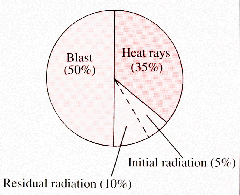 The Diagram of Energy
Released
The Diagram of Energy
Released
The building which is now known as the A-bomb Dome was built in 1915 as the Hiroshima Prefectural Products Exhibition Hall. Later the name was changed to the Hiroshima Prefectural Commercial Exhibition Hall and finally to the Hiroshima Prefectural Industrial Promotion Hall. It was designed by Jan Letzel, a Czech architect, and, as the city's most elegant and artistic building, was a source of pride for Hiroshima citizens. To the west of the building was a unique T-shaped bridge, the Aioi Bridge, which served an important role of joining east and west sections of the city with the Nakajima and Yoshijima districts to the south. The Aioi Bridge is said to have been the target when the A-bomb was dropped.
Research to date has indicated that the actual point where the A-bomb exploded was approximately 300 meters southeast of Aioi Bridge, approximately 580 meters above the Shima Hospital in the district that was previously called Saiku-machi. (The ground directly below the point where the bomb exploded is referred to as the hypocenter.)
The temperature of the air at the point of explosion reached several million degrees Celsius (the maximum temperature of conventional bombs is approximately 5,000 Degrees Centigrade). Several millionths of a second after the explosion a fireball appeared, radiating white heat. After 1/10,000 of a second. the fireball reached a diameter of approximately 28 meters with a temperature of close to 300,000 degrees Centigrade. At the instant of explosion, intense heat rays and radiation were released in all directions, and a blast erupted with incredible pressure on the surrounding air.
Of the energy released, approximately 35 percent was in the form of heat rays, 50 percent as blast wind, and 15 percent as radiation (5 percent as initial radiation and 10 percent as residual radiation).
The Diagram of Energy Released
The cloud generated by the disturbed air resulting from the explosion was lifted upward by strong currents. As the pillar of radiation-laden smoke reached the bottom of the stratosphere, it spread out horizontally to a diameter of several kilometers, forming the shape of a mushroom cap.
After developing into this final stage, the mushroom cloud was dispersed by the wind and dissipated into the surrounding air.